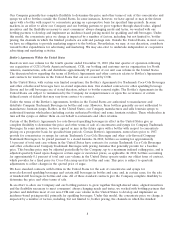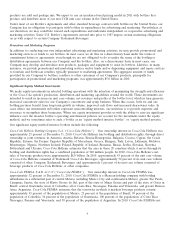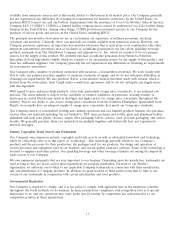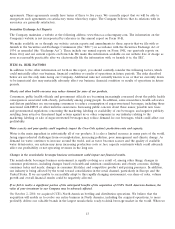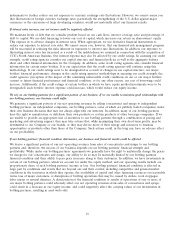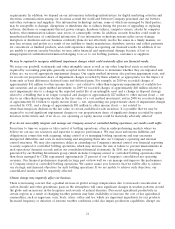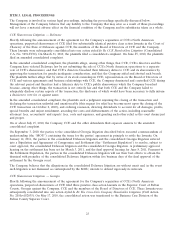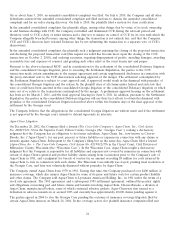Coca Cola 2010 Annual Report Download - page 17
Download and view the complete annual report
Please find page 17 of the 2010 Coca Cola annual report below. You can navigate through the pages in the report by either clicking on the pages listed below, or by using the keyword search tool below to find specific information within the annual report.may be negatively affected, which could increase our cost of borrowing. In addition, the current uncertain credit market
conditions may make it more difficult for our bottling partners to access financing on terms comparable to those
available prior to the global credit crisis, which would affect the Coca-Cola system’s profitability as well as our share of
the income of bottling partners in which we have equity method investments. The current uncertain global credit
market conditions and their actual or perceived effects on our and our major bottling partners’ results of operations
and financial condition, along with the current unfavorable economic environment in the United States and much of the
world, may increase the likelihood that the major independent credit agencies will downgrade our credit ratings, which
could have a negative effect on our borrowing costs.
The significant decline in the equity markets and in the valuation of other assets precipitated by the global credit crisis
and related financial system instability affected the value of our pension plan assets. In spite of improving asset values
in late 2009 and 2010, the fair value of our plan assets remains lower than pre-crisis levels, and this could lead to higher
pension expense in the future.
In addition, some of the major financial institutions remain fragile, and the counterparty risk associated with our
existing derivative financial instruments remains higher than pre-crisis levels. Therefore, we may be unable to secure
creditworthy counterparties for derivative transactions in the future or may incur higher than anticipated costs in our
hedging activities. The decrease in availability of consumer credit resulting from the financial crisis, as well as general
unfavorable economic conditions, may also cause consumers to reduce their discretionary spending, which would reduce
the demand for our beverages and negatively affect our net revenues and the Coca-Cola system’s profitability.
Increased competition could hurt our business.
The nonalcoholic beverages segment of the commercial beverages industry is highly competitive. We compete with
major international beverage companies that, like our Company, operate in multiple geographic areas, as well as
numerous companies that are primarily local in operation. In many countries in which we do business, including the
United States, PepsiCo, Inc., is a primary competitor. Other significant competitors include, but are not limited to,
Nestl´
e, Dr Pepper Snapple Group, Inc., Groupe Danone, Kraft Foods Inc. and Unilever. In certain markets, our
competition includes major beer companies. Our beverage products also compete against local or regional brands as
well as against store or private label brands developed by retailers, some of which are Coca-Cola system customers. Our
ability to gain or maintain share of sales or gross margins in the global market or in various local markets may be
limited as a result of actions by competitors.
If we are unable to expand our operations in developing and emerging markets, our growth rate could be negatively affected.
Our success depends in part on our ability to grow our business in developing and emerging markets, which in turn
depends on economic and political conditions in those markets and on our ability to acquire or form strategic business
alliances with local bottlers and to make necessary infrastructure enhancements to production facilities, distribution
networks, sales equipment and technology. Moreover, the supply of our products in developing and emerging markets
must match consumers’ demand for those products. Due to product price, limited purchasing power and cultural
differences, there can be no assurance that our products will be accepted in any particular developing or emerging
market.
Fluctuations in foreign currency exchange rates could affect our financial results.
We earn revenues, pay expenses, own assets and incur liabilities in countries using currencies other than the U.S. dollar,
including the euro, the Japanese yen, the Brazilian real and the Mexican peso. In 2010, we used 74 functional
currencies in addition to the U.S. dollar and derived approximately $24.5 billion of net operating revenues from
operations outside the United States. Because our consolidated financial statements are presented in U.S. dollars, we
must translate revenues, income and expenses, as well as assets and liabilities, into U.S. dollars at exchange rates in
effect during or at the end of each reporting period. Therefore, increases or decreases in the value of the U.S. dollar
against other major currencies will affect our net operating revenues, operating income and the value of balance sheet
items denominated in foreign currencies. In addition, unexpected and dramatic devaluations of currencies in developing
or emerging markets, such as the devaluation of the Venezuelan bolivar, could negatively affect the value of our
earnings from, and of the assets located in, those markets. Because of the geographic diversity of our operations,
weaknesses in some currencies might be offset by strengths in others over time. We also use derivative financial
15





